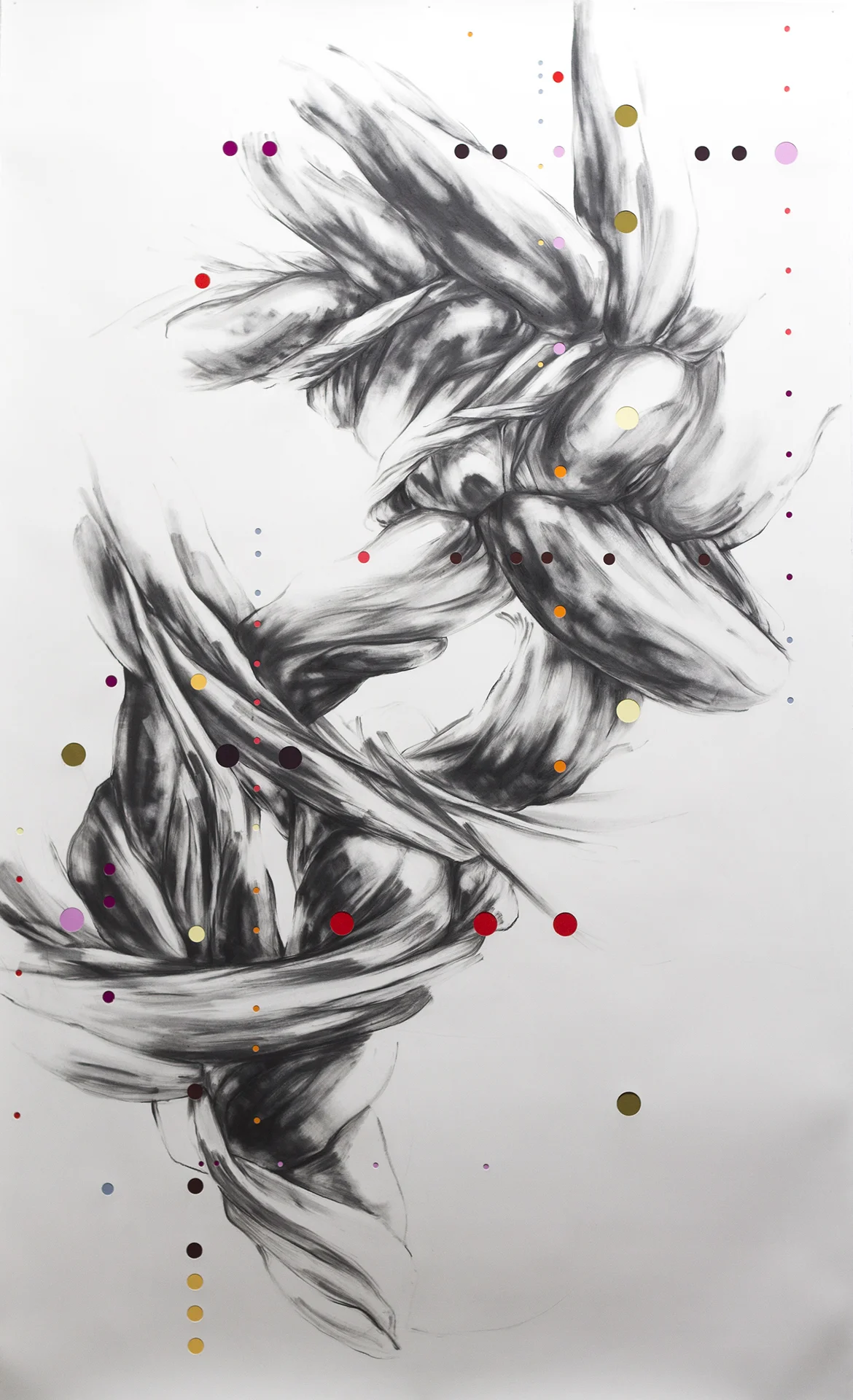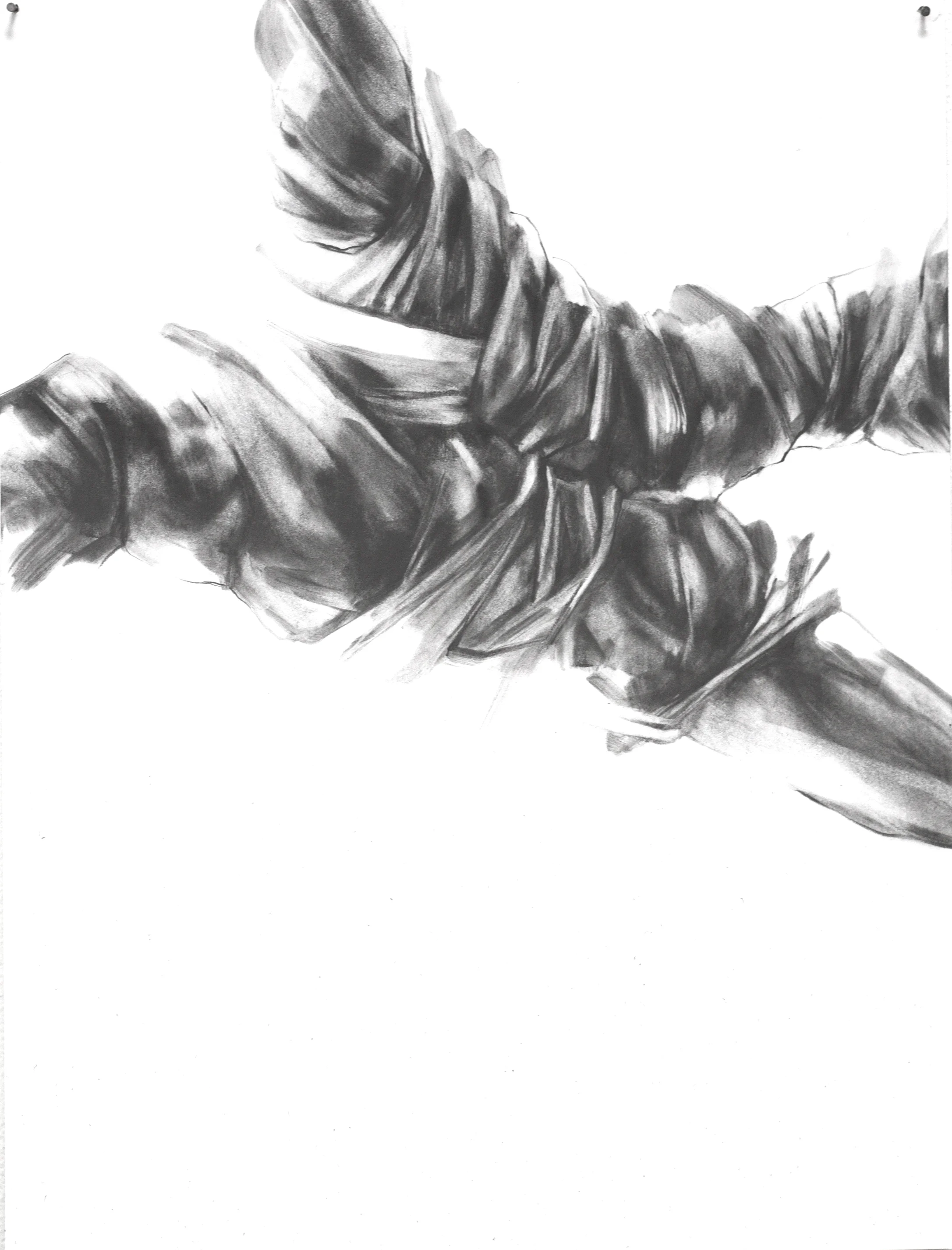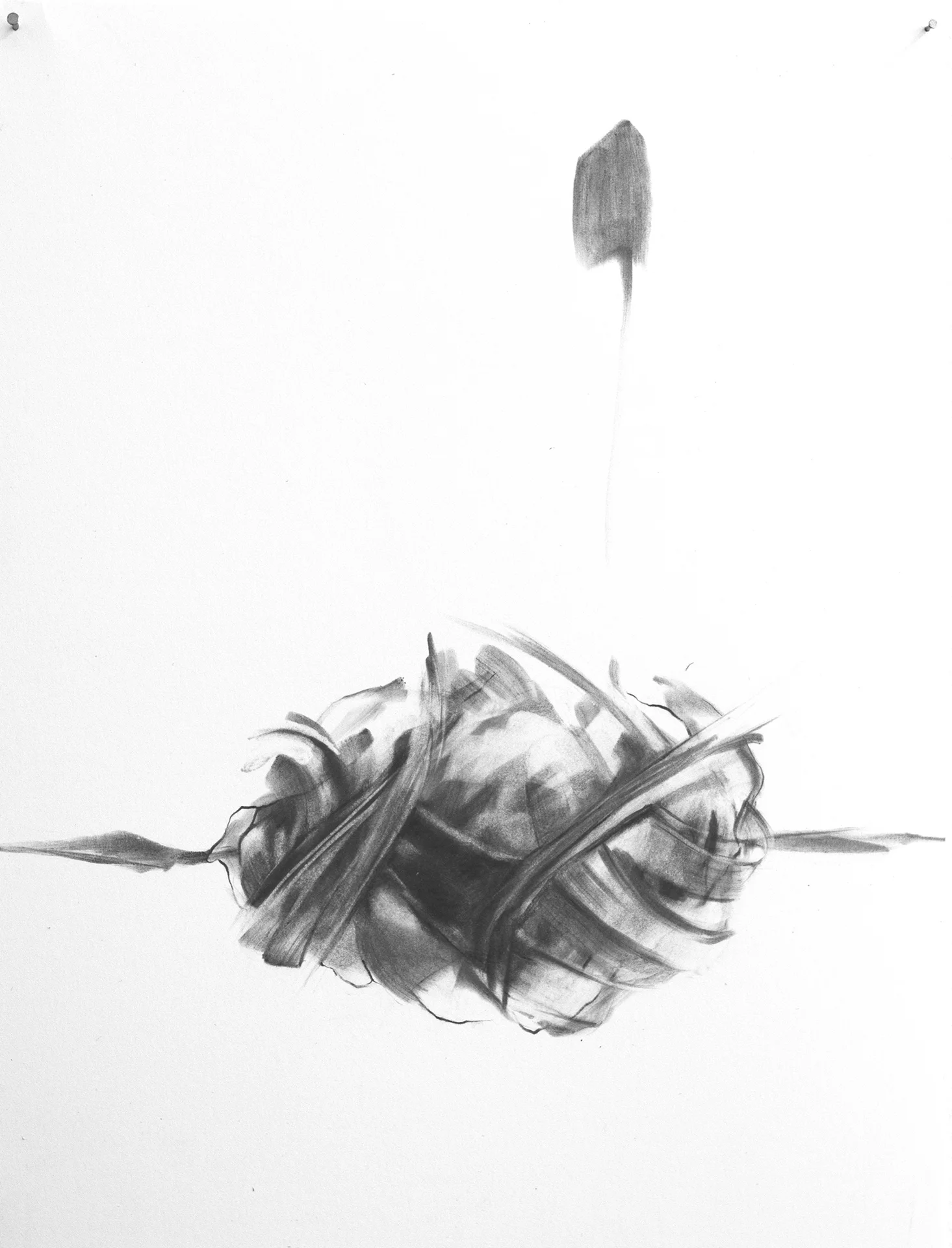
Figure 1: Nancy Baker Cahill, Surd No. 17 (2016), Graphite and mixed media on punctured paper, 26 x 28 inches
by Gracie Linden
Nancy Baker Cahill’s Manifesto No. 9 (2016) [Fig. 2] shows two graphite explosions side by side. Like two supernovas, the drawing pulsates with energy, the grey lines radiating violently outwards. Cahill investigates the corporeal, and when seen next to other works that represent the abstracted body, Manifesto No. 9 becomes bodily, morphing into two orifices or wounds. Simultaneously suggestive of pain and nurture, the distorted forms may not be obviously recognizable as human, but they are biological. Two of her most recent series of works, the SURDS drawings and MANIFESTO (SMALL DRAWINGS), reduce the body to its purest form and expression. By doing so, the drawings capture the distinct forces that act on the body, and the ways it can be restricted and contained to both protect and harm.

Figure 2: Manifest No. 9 (2016), Graphite on paper, 12 x 9 inches
Cahill has always been drawn to narratives concerning such themes as chaos, resistance, and destruction with the hope of finding threads of optimism and empathy.[1] She finds inspiration in an array of sources such as Dante’s The Inferno, choreographer Pina Bausch, fashion designer Alexander McQueen, and artists Egon Schiele and Louise Bourgeois. Although diverse and wide-reaching, these are artists linked by a desire to work with and investigate the body. As such, perhaps the starting point for understanding Cahill’s works can be found not with the artist herself but rather in Maggie Nelson’s The Argonauts (2015) which traces Nelson’s romance with Harry Dodge and the growth of their family (and strongly influenced Cahill). Nelson, a political queer, becomes pregnant at the same time that Dodge begins taking testosterone. The Argonauts repeatedly questions ideas of permanence, stability, ambiguity and ambivalence, particularly in relation to the body. Nelson closely examines both her own, and Harry’s, physical transformations, talking about “2011, the summer of our changing bodies. Me, four months pregnant, you six months on T”;[2] how pregnancy adds a space that didn’t exist before[3]; how Harry lived between genders and between bodies.
Cahill’s drawings deal in this same uncertainty, in the space of queer politics where the binaries of male/female, pain/pleasure and nurture/neglect can be challenged and upended. She sees the body as “a complicated abstraction”[4] and one that is never fixed. Like Nelson, Cahill’s SURD series looks at chaos and impermanence. Consider Surd 12 (2016): This graphite drawing shows a twisting rope-like knot that can be anthropomorphized. The form is neither masculine nor feminine, but it feels entirely like a body nonetheless. In one direction, it has what could be a protruding, pregnant-like belly—a “capacious”[5] space. From the other, it looks entirely muscular, leaping with boundless energy, which resists being captured in a state of constancy.
Cahill explains that the SURD drawings are her attempt to “dissect notions of power moving over and through the body.”[6] Her conceptualization of a surd—a concept used in both mathematics and phonetics—is rooted in Susan J. Brison’s definition as found in Aftermath: Violence and Remaking of the Self (2003). Brison used a surd as a metaphor for chaos and disruption; something that extinguishes coherence in what was otherwise an orderly, predictable sequence. Brison explains that the surd makes it “impossible to carry on with the series”[7] or life as it was. Cahill herself has long been interested in trauma, stemming from a fascination with narratives that are shaped through resistance and struggle. Brison’s book, for Cahill, is an attempt to clarify suffering, a quest which has no clear answer.[8]
All of the SURD works are punctured by grid-like patters of small circles of varying sizes filled in with colored flat discs or mounted in relief on the surface—the surds themselves. The pairing of the measured geometric grid with the organic bodily shapes accentuates a sense of tension within the works, expressed most directly through the visual tautness of the twisted forms. If the surds represent that force which disrupts order, or as the artist declares, “power moving over and through the body,” is it not also possible to see their orderly arrangement as offering the means to restore order and coherence through healing? For instance, Surd 16 (2016) [Fig. 3] underscores the difficulties in identifying what component is meant to evoke rationality.

Figure 3: Surd No. 16 (2016), Graphite and mixed media on punctured paper, 91 x 55 inches
The ropes—or maybe they are braided fabric strips—are taut; however, tension, especially in the context of fit bodies or in engineering, is an expression of order lending added stability and strength against external forces (that which is pliable bends, that which is rigid breaks). The surds, on the other hand, overlay the organic shapes, extending beyond their boundaries into the negative space of the composition. It is difficult to determine whether or not they impose order from above or express a system of order emanating from the body itself. If we compare this work to Eva Hesse’s early gridded drawings which examine the inelasticity of order, such as Untitled (1967) [MoMA 1101.1983], we find that Hesse’s grids function like cells for the organic, circular components they contain. Conversely, Cahill’s SURDS appear rather as traces of events, or constellations against which bodies maneuver and resist. Looking further afield, to non-western representations of bodily meridians and acupuncture points offers another way of interpreting the surds – as expressions of healing systems of order underlying the surface of bodies. Thus, whereas Cahill’s surds represent external disruptive episodes inserted into a series of predictable life events which act upon the body and its nervous system, paradoxically, the grid-like arrangement also reflects the ordered systems of bodily interiors, appearing in the drawings much as we might envision Brison's orderly numeric series (2, 4, 6...) which surds are meant to disrupt. The potential for double reading is further emphasized by the artist's process of incorporating the surd elements into the graphite composition.
There is, explains Cahill, something inherently violent in puncturing paper.[9] And it is risky to bring injury to what is being created. The body and the paper—both are in a constant state of transformation, of becoming new and different. To return to Nelson’s narrative, to become more male, Dodge is forced to remove parts of his body. Likewise, the surds damage the surface to find that moment of becoming. Both the body remaining and the body removed bear witness to one another. Observing both her own bodily changes as well as Dodges, Nelson explains, “On the inside, we were two human animals undergoing transformations beside each other, bearing each other loose witness.”[10]

Figure 4: Manifesto No. 23 (2016), Graphite on paper, 12 x 9 inches
Both the SURD series and the MANIFESTOS (SMALL DRAWINGS) depict these rope-like images, and the influences of artists such as Hesse and Kiki Smith are clear. Indeed, Hesse’s rope and latex sculpture Untitled (1969-1970) [Whitney 88.17a-b] seems to be a three-dimensional representation of one of Cahill’s drawings. Hesse’s sculptures are experiments in materiality and the works cry out to be touched. This allows for a sort of “bodily empathy”[11] that can only be achieved through physical contact. Touch would also allow one to enter the space of the sculpture; since Untitled has no enclosing shape, there is no beginning or end, no inside or exterior. This quality is also apparent in Cahill’s drawings in which the sense of enfolding and envelopment eliminates any obvious entry point.
Curator Elizabeth Sussman described Hesse’s latex works as well as her wrapped pieces as “mummification”[12] an element that should be examined in light of Cahill’s drawings. True, Cahill's drawings are illusionistic and do not involve wrapped sculptural forms. But by anthropomorphizing the forms, the drawings nonetheless are transformed into quasi-mummies. Manifesto No. 23 (2016) [Fig. 4] perhaps alludes most clearly to mummification: like Hesse’s Ingeminate (1965), Manifesto No. 23 shows two sausage shapes of wrapped cloth. Both works’ phallic forms are immediate reminders of the body. Although the ancient Egyptians only preserved certain organs, these here resemble the unearthed kidneys from an ancient corpse.
The preservation of the body hints not only at ancient Egyptian practices but also, as Sussman writes, “loving preservation or controlled sadism.”[13] This duality, violence and softness, is felt in both the SURD series (aggression) and the MANIFESTOS (protection). What is the body if not the site of a constant struggle between preservation and outward interaction? Can these be both objects to shield and objects to fetishize? Each of these womb-like MANIFESTOS emanates warmth and care as well as a fixation on the body’s interiority. Manifesto No. 6 (2016) [Figure 5] depicts a small ball of wrappings with two strands pulled out of either side. This self-contained bundled could be destroyed with two gentle tugs. The precariousness—at the precipice of unbecoming—contradicts the severe bindings, and this tension is revealed in Cahill’s soft grey tones.
Cahill’s work with the imagery of the internal body is influenced by Kiki Smith who she cites as one of her key inspirations. Smith’s sculptures, such as the delicate Ribs (1987), are more overtly representational than either Cahill’s or Hesse’s works; in fact, Smith relied on Grey’s Anatomy as source material.[14] Made of terra cotta and shown without a body, Ribs’ fragility is essential to the piece itself. As an artist, Smith is concerned with “the human form as a vessel for the expression of affect,”[15] a theme and sensitivity found in Cahill’s drawings. What links Smith, Cahill and Hesse is this focus on affect, which emphasizes bodily experience, over precise representation. Similarly, affect is ultimately what The Argonauts explores and documents: how do bodies both experience and allow for expression?

Figure 5: Manifesto No. 6 (2016), Graphite on paper, 12 x 9 inches
In this sense, to speak of affect is to speak of abjection which Juliet Kristeva defines is that which distinguishes man from animal.[16] In Powers of Horror, Kristeva writes that abjection is “not lack of cleanliness or health…but what disturbs identity, systems, order.” [17] The abject was a theme of much feminist art in the 1970s, a period that succeeded Hesse and greatly influenced Smith. It is also the subject of much of Nelson’s The Argonauts which chronicles the “obscene”[18] body and its interiors. By exposing and representing bodily affect through abjection, these artists engage with the social hierarchies and dynamics at play. Cahill comes decades after these first feminist artists, but her work grapples with similar questions of body, pain, and power—how much can the body take.
Questions of subjection are manifested in the elasticity of Cahill’s ropes which pull and strain as they bind the “bodies”. Pull too hard and the cords could snap; release all tension and the entire composition could fall to pieces. This not-yet moment of the breaking point is exactly what Cahill’s drawings capture in all its forms. What makes the drawings powerful, what ensures that viewers look and look again, is this repellant magnetism between the SURD series and the MANIFESTOS. Eternally in opposition, nonetheless they are in dialogue with one another. The space in-between the two is a captivating, if often overlooked, force. As Nelson writes, “How to explain that for some, or for some at some times, this irresolution is OK…whereas for others, or for others at some times, it stays a source of conflict or grief?”[19]
Cahill has long been drawn to works that address power in some way or another, or, as she explains, “who has it, who doesn’t, who is abusing it, who is subverting it, war-stories, strategic jockeying, triumphant escapes, coups and come-uppances of all kinds.”[20] But to understand power, means to also grapple with powerlessness, to know that strength comes in many forms, and that the body is capable of many unknowns. The SURDS and MANIFESTOS portray power as strength and also as protection, and encourage a mutable understanding of both.
Learn more about Nancy on her Artist Profile.
[1] Email conversation with the artist, 22 August 2016.
[2] Maggie Nelson, The Argonauts (London: Melville House, UK, 2015) p. 99
[3] Nelson, The Argonauts p. 128
[4] From the artist’s website, accessed 21 August 2016
[5] Nelson, p. 128
[6] From the artist’s website, accessed 21 August 2016
[7] Susan Brison, Aftermath: Violence and the Remaking of the Self (Princeton University Press, 2001) p. 104
[8] Email conversation with the artist, 22 August 2016
[9] Email conversation with the artist, 17 August 2016
[10] Nelson, p. 103
[11] Exhibition Catalogue, Eva Hesse edited by Elizabeth Sussman (New Haven, CT: Yale University Press, 2002) p. 93
[12] Eva Hesse p. 178
[13] IBID.
[14] “Kiki Smith | Ribs” The Guggenheim, accessed on 14 September 2016. https://www.guggenheim.org/artwork/3957
[15] IBID.
[16] Julia Kristeva, Powers of Horror: An Essay on Abjection Trans. Leon S. Roudiez (New York: Columbia University Press, 1982) p. 12
[17] Kristeva, Powers of Horror: An Essay on Abjection, p. 4
[18] Nelson, p. 109
[19] Nelson, p. 66
[20] Email communication with artist, July 16 2016.






